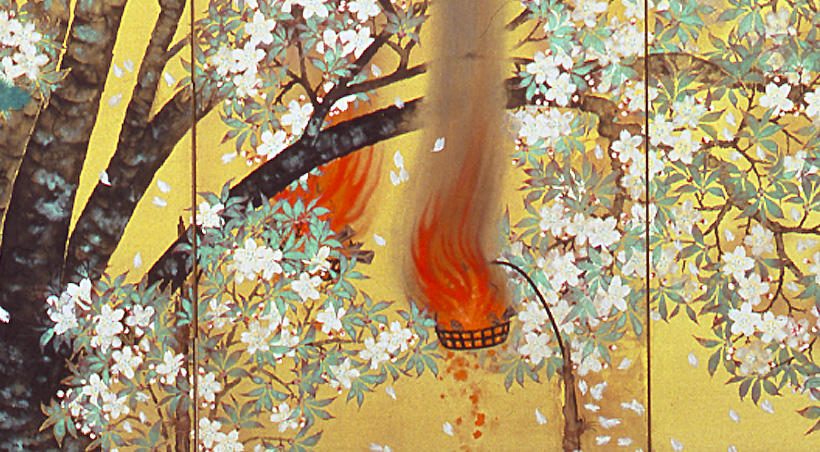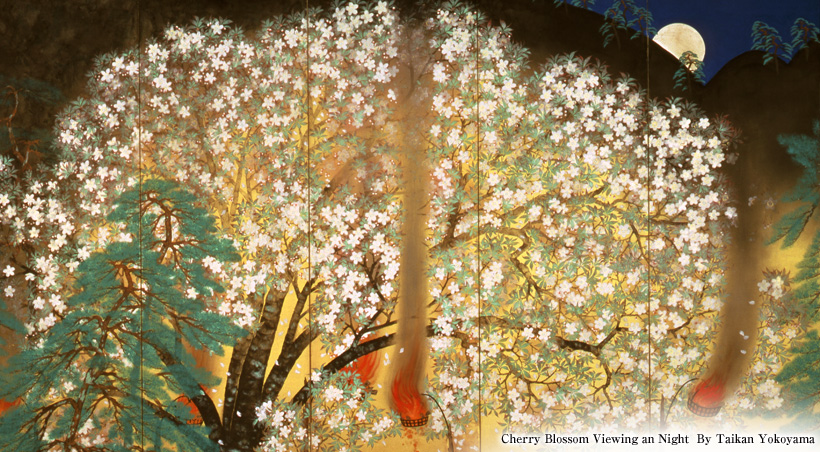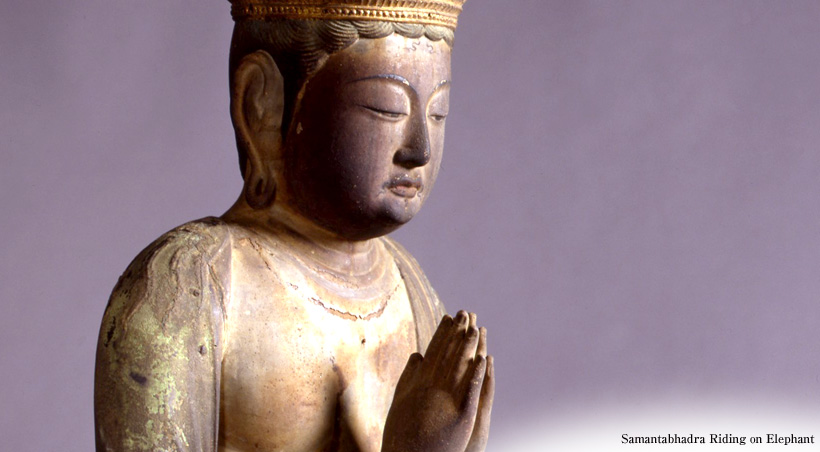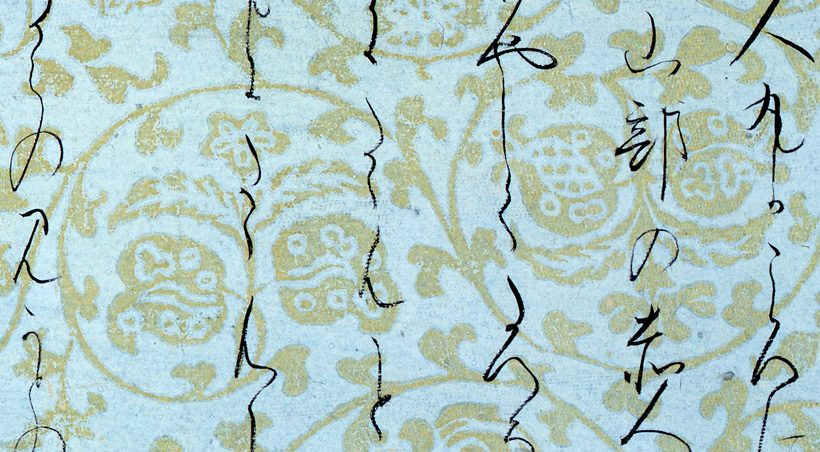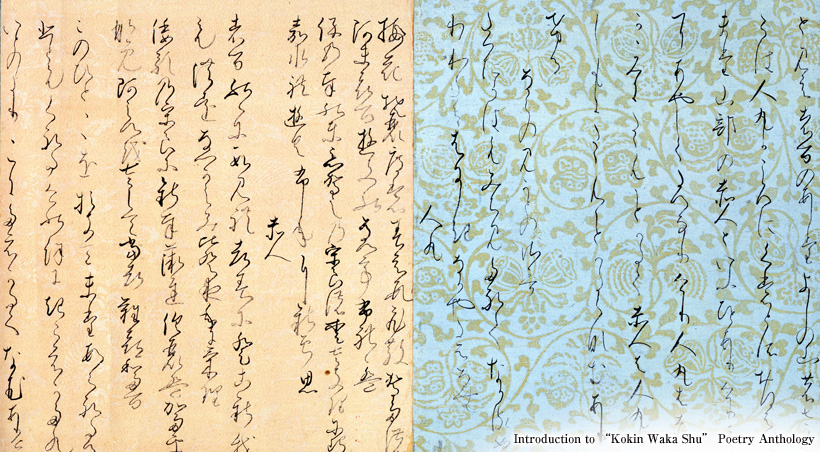Okura Shukokan is an art museum founded by Kihachiro Okura. Since the Meiji Restorasion in 1868, he devoted himself not only to the development of industry and foreign trade in the newly rising Japan, but also made a great contribution to fostering educational and welfare services in the Meiji Era(1868-1912). For him it was a tragedy to see so many of Japan's cultural treasures leaving the country. He, therefore, willingly offered himself as a guardian and promoter of our original culture, and eventually donated to the public a mass of cultural property which he had collected during an expanse of over half a century since the Restoration, together with land , buildings, and supporting funds. This is the Foundation called the Okura Shukokan, established in August, 1917. It was indeed a forerunner of private art museums in Japan.
Having been established at this time, this museum was exposed to the Great Earthquake and fire of 1923, and a vast quantity of its collection was lost to us. However, renewed efforts were made under the direction of Dr. Chuta Ito, to reconstruct a new quake-and-fire-proof gallery, which was opened to the public in October, 1928. The museum, containing original items which escaped the catastrophe together with additions made since that time, was thus restored.
Kishichiro Okura, who acted in accordance with the will of the deceased Kihachiro, gave generous support to the maintenance of the gallery during and after World War II. He personally donated a large amount of important cultural property which he himself had collected during his lifetime, which constitute a substantial addition to the bequeathed wealth of the museum.
The collection consists of about 2500 works of art, and about 1000 volumes of books. The entire collection includes 3 National Treasures, 13 Important Cultural Properties, and 44 Important Art Objects.
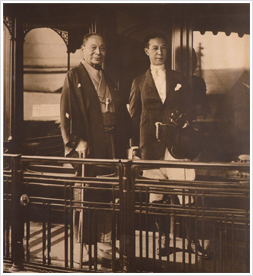 Kihachiro Okura(left)
Kihachiro Okura(left)Kishichiro Okura(right)
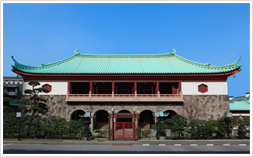 The Okura Shukokan(Okura museun of art)
The Okura Shukokan(Okura museun of art)
Since April 1st 2014, We are temporarily closed for renovation.
What is Okraulo?
Okraulo is a metal recorder invented and produced in the early Showa period (at the beginning of the 20th century) by Baron Kishichiro Okura (1882~1963), who was known as the founder of Hotel Okura, with a view to playing Western music through the sound of shakuhachi (a five-holed bamboo flute) that he played himself. Whereas the number of finger holes of the traditional shakuhachi is five, that of Okraulo is 15 to 16, the same as that of a flute because the keywork of the flute was introduced into Okraulo. For shakuhachi, it is equivalent to one with many tone holes. While music activities using Okraulo, including developing performers and holding regular concerts by a band, had been actively conducted from the middle of the 1930s to the 1940s, after zaibatsu was dissolved following the end of the war, it became difficult for the Okura Family to back up these activities. In consequence, the opportunities of concerts plummeted and Okraulo ended up as a long-forgotten, phantom musical instrument.
You can imagine shakuhachi to be a musical instrument made of bamboo but it may be difficult to instantly recall the shape of its utaguchi (mouthpiece) i.e., the part that your lips should be on. The head joint of Okraulo has a shakuhachi-style mouthpiece. As a general impression, it may look like you are playing the flute vertically. The sound is more of a hybrid of shakuhachi and a flute, featuring clear sound typical of a metal pipe combined with shakuhachi’s rich power of expression that makes human breath felt, which is its big appeal.
In 2011, Okura Museum of Art kicked off activities to revive Okraulo prior to the 50th anniversary of Kishichiro’s death. Through various activities, such as concerts, CD sales and reproduction of the instrument, its hybrid appeal attributable to the Japanese sprit combined with Western learning is garnering attention anew right now.
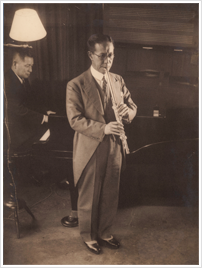 Kishichiro Okura plays Okraulo,
Kishichiro Okura plays Okraulo,with Takashi Iba(pf), 1936
History of Okraulo
Kishichiro, who succeeded to the Okura zaibatsu from his father Kihachiro, who passed away in 1928, made notable achievements as a Japanese hotelier among others while focusing on cultural activities and being unstinting in his support for the music arena. Based on his experience of studying at the University of Cambridge, the U.K. when he was young, he contributed to making Western music become widespread in Japan by sponsoring orchestras or composition contests while showing his deep love to Japanese traditional music. He established the new Japanese school of music Yamatogaku from the end of the Taisho period to the beginning of the Showa period and invented and produced the new musical instrument Okraulo. Kishichiro was good at playing the shakuhachi himself but he was not satisfied with the simple structure of the pipe that was used in those days and thought of improving it so that the twelve-tone equal temperament of Western music can be played with the accurate chromatic scale. It was 1935 when a prototype of the Okura-style shakuhachi made in this way was unveiled under the name of Okraulo, more than ten years after it was first conceived. The name Okraulo, based on an association with Okura’s family name and the Aulos, the ancient Greek end-blown flute, was given by music critic Takashi Iba, who also assumed the post of chairman of the Okraulo Institute.
Not only the number of finger holes was increased but their width was expanded as well to allow the Boehm system keywork applied to the flute to be introduced into Okraulo. Moreover, instead of bamboo, metals, such as silver, came to be applied as material. Other than the head joint that has the shakuhachi-style mouthpiece, Okraulo has nearly the same structure as the flute does but in terms of its details, ingenuity was exercised to make it closer to shakuhachi, with the shape of keywork being finely tuned to be in line with specifications of the recorder. It also comes with a finger rest on the back so that the shakuhachi-specific vibrato, such as kubi furi (a head shake), may be expressed.
After Kishichiro visited Rudall Carte, a flute maker based in London, the U.K., in person to ask them to make Okraulo, five types of the instrument were made, namely, in addition to a standard soprano pipe, piccolo, sopranino, alto and basso pipes. The Method for Okraulo was published the following year; when trainees were called to gather at the office of the Okraulo Institute on the second floor of the Sippo Building in Ginza, besides Kishichiro, up-and-coming shakuhachi performers, such as Iccho Koga, Seicho Kishi, Shincho Fukuda (Rando Fukuda) and Wacho Araki (Kodo Araki IV), took the lead in giving instructions.
With the Pacific War approaching, musical activities had been carried out, with a training school being established and regular concerts being organized by a band five times in total. Whereas primarily sankyoku (koto, shamisen and shakuhachi) was performed in a practice session at first, the band came to commit itself to Western classical music gradually. As flutist Seizo Miyata joined as an instructor at the training school, performing Western music by shakuhachi, i.e., Kishichiro’s big vision, was brought a step closer to fulfillment on the one hand; on the other hand, it was exposed to an easy comparison with the flute; as a result, Okraulo was given a negative image as it was perceived to be on neither side as a music instrument, which was ironical. Tansui Kikuchi, a member of the band, had used Okraulo in taking a folk melody from various parts of Japan down in staff notation for a while after the war. Its existence ended up being forgotten little by little, however. Production of the instrument by Japanese makers, including Nikkan, during the war had no choice but to meet with a setback, with issues, such as improvement of performance or reduction in production cost remaining unsolved.
In this way, Okraulo became a very phantom music instrument, whose existence is merely passed on to the next generation as part of the history of Japanese music, on the back of rapid westernization of the Japanese music market after the war.
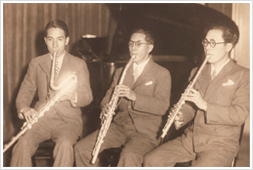 Shincho Fukuda(B.okraulo), Seicho Kishi(A.okraulo), Iccho Koga(S.okraulo), 1936
Shincho Fukuda(B.okraulo), Seicho Kishi(A.okraulo), Iccho Koga(S.okraulo), 1936
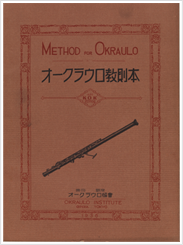 Method for Okraulo, By Iccho Koga, 1936
Method for Okraulo, By Iccho Koga, 1936
 Okraulo
Okraulo(Okura style
shakuhachi)
Wakamatsu, Japan
ca.1930
 Alt okraulo
Alt okrauloRUDALLL, CARTE &
CO, LTD, LONDON
ca.1939
 Bass okraulo
Bass okrauloRUDALLL, CARTE &
CO, LTD, LONDON
ca.1939
Reviving of Okraulo
In the summer of 2011, prior to the 50th anniversary of Kishichiro Okura’s death, the exhibition titled “Okura Kishichiro and Japanese Music Centered on Okraulo, Phantom Recorder” was organized at the Okura Shukokan Museum. The exhibits included Kishichiro’s achievements in the Japanese music arena, musical instruments and literature and material associated with Okraulo’s history. Along with Okraulo concerts performed several times during the exhibition period, the event drew more-than-expected visitors.
With this as a start, the project to revive Okraulo was launched. Shakuhachi player Akihisa Kominato played Okraulo and an original CD titled “OKRAULO” by the Okura Shukokan Museum was released the following year. This has been followed by dozens of Okraulo concerts with commentary by a curator in charge organized at the Okura Museum of Art and Hotel Okura Tokyo. At first, the Okura-style shakuhachi (made by Wakamatsu in 1935) was used and a prototype of a new Okraulo was completed at the end of 2012. This is based on the Okura-style shakuhachi (made by Wakamatsu), featuring a mouthpiece with better performance, and entirely made of silver. This has gone through a series of minor changes to date. The Okura Cultural Foundation registered the trademark of Okraulo in 2013 while working on reproducing the musical instrument as well.
In addition, we repaired alto and bass pipes made by Rudall Carte about 80 years ago and built a new head joint fitted with a better mouthpiece for them. Naoki Matsushita and Hiromu Motonaga took charge of playing the instrument, respectively, and activities by a trio with a soprano by Kominato have also started. In August 2015 the second CD titled “Okraulo 2 – Rainbow Prism” was released, with the scale of activities expanding step by step. The new appeal of Okraulo, which freely goes back and forth between the Western and Oriental boundaries, has drawn attention of various media ranging from TV to radio, to newspapers and magazines. Albeit shakuhachi, it not only can deal with the chromatic scale but allows you to enjoy playing the flute vertically as well. I believe that Okraulo may be able to expand the possibility of the performance of a wide array of world music genres, seeking music none other than Okraulo can create that differs from music of both shakuhachi and the flute. Now that the phantom music instrument originally built 70 years ago was reproduced, we hope to be able to nurture the potential of Okraulo, which heads into the future, together with you.
Chisako Tanaka (Curator, Okura Museum of Art)
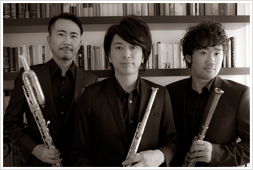 Akihisa Kominato(S.okraulo),Naoki Matsushita(A.okraulo),Hiromu Motonaga(B.okraulo),2015
Akihisa Kominato(S.okraulo),Naoki Matsushita(A.okraulo),Hiromu Motonaga(B.okraulo),2015©Yasunari Suda
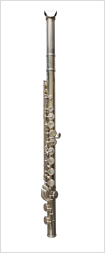 Soprano Okraulo, 2013
Soprano Okraulo, 2013Okura Public Curtural
Foundation®

